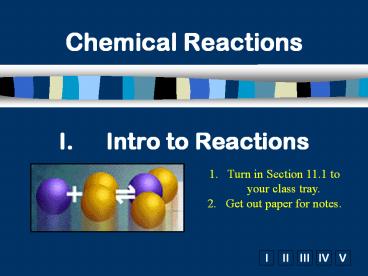Intro to Reactions - PowerPoint PPT Presentation
Title:
Intro to Reactions
Description:
Chemical Reactions Intro to Reactions Turn in Section 11.1 to your class tray. Get out paper for notes. Why are Chemical Reactions Important? Chemical reactions occur ... – PowerPoint PPT presentation
Number of Views:114
Avg rating:3.0/5.0
Title: Intro to Reactions
1
Intro to Reactions
- Chemical Reactions
- Turn in Section 11.1 to your class tray.
- Get out paper for notes.
2
Why are Chemical Reactions Important?
- Chemical reactions occur everywhere.
- Your body is a chemical machine, if chemical
reactions did not occur, we would not be alive.
3
A.Signs of a Chemical Reaction
- Evolution of heat and light
- Formation of a gas
- Formation of a precipitate
- Color change
4
B.Law of Conservation of Mass
- mass is neither created nor destroyed in a
chemical reaction
- total mass stays the same
- atoms can only rearrange
4 H 2 O
4 H 2 O
36 g
4 g
32 g
5
C. Chemical Equations
- AB ? CD
REACTANTS
PRODUCTS
6
C. Chemical Equations
7
D. Writing Equations
2H2(g) O2(g) ? 2H2O(g)
- Identify the substances involved.
- Use symbols to show
- How many? - coefficient
- Of what? - chemical formula
- In what state? - physical state
- Remember the diatomic elements.
8
D. Writing Equations
- Two atoms of aluminum react with three units of
aqueous copper(II) chloride to produce three
atoms of copper and two units of aqueous aluminum
chloride.
- How many?
- Of what?
- In what state?
? 3
Al
2
(s)
3
CuCl2
(aq)
Cu
(s)
2
AlCl3
(aq)
9
E. Describing Equations
Zn(s) 2HCl(aq) ? ZnCl2(aq) H2(g)
- How many?
- Of what?
- In what state?
One atom of solid zinc
reacts with
two molecules of aqueous hydrochloric acid
- to produce
one unit
of aqueous zinc chloride
and one
molecule of hydrogen gas.
10
II. Balancing Equations
- Ch. 11 Chemical Reactions
Get out your notes from yesterday and your
practice sheet
11
Counting Atoms
- How many atoms of each element are in the
following molecules? - 1. H2SO4
- 2. Ca(OH)2
- 3. NaCl
- 4. (NH3)3P04
- 5. 3H2O
- 6. 4Al2(CO3)3
12
B. Helpful Tips
- Balance one element at a time.
- Update ALL atom counts after adding a
coefficient. - If an element appears more than once per side,
balance it last. - Balance polyatomic ions as single units.
- 1 SO4 instead of 1 S and 4 O
13
C. Balancing Example
- Aluminum and copper(II) chloride react to form
copper and aluminum chloride.
3
3
2
2
1 1 1 1 2
3
2 ?
? 2 ? 6
3 ? 6 ?
? 3































